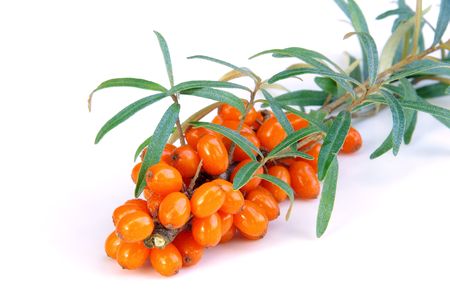
The Sea Buckthorn (Hippophaë rhamnoides L.) (Family: Elaeagnaceae) is a widely distributed plant throughout Europe and Central Asia. The plant is now widely cultivated in Russia, China, India as well as Europe.
Growing Habit
Sea Buckthorn is a branched and thorny deciduous shrub noted for its nitrogen-fixing abilities. The shrub is grown as a garden plant in coastal areas and mainly thrives in temperate regions. It dislikes tropical conditions.
It is noted from a horticultural point of view for having red, orange and yellow berries that only appear on 2-year old thorny twigs (Korekar et al., 2011).
The shrub has been extensively used in traditional medicines for millennia.
Properties Of The Seed Oil
The seed oil is perhaps the most important component of the plant. It has been shown to have a number of clinically beneficial properties in animals and cell studies although there are no clear claims to be made for it where humans are concerned, however the research into the berry and its seeds continues unabated. There are some good quality clinical studies with humans but replication is needed to fully assure medical researchers of its efficacy.
The seed oil has the following associated clinical benefits:-
– Reduction of atherogenesis by reducing lipid and plaque deposition in the arteries (Basu et al., 2007) in animal studies.
– A decrease in oxidative stress (Suleyman et al., 2002) in animal studies.
– An indication that coronary heart disease (CHD) is reduced (Eccleston et al., 2002) in a human study.
– The prevention of platelet aggregation (Johansson et al., 2000).
– Lowering the plasma high sensitivity c-reactive protein level (Larmo et al., 2007).
– Improvement in burn and wound healing in a rat model (Upadhyay et al., 2009).
A wide ranging review on the medicinal properties should be consulted by Suryakumar and Gupta (2011) and by Stobdan et al., (2013).
The berries of the sea buckthorn are especially rich in various bioactive substances with high nutritional and medical value. They offer a wealth of antioxidant and signal-modulating activities.
The seed oil is rich in bioactive substances like carotenoids, tocopherols, omega-3 and omega-6 fatty acids and phytosterols (Basu et al., 2007).
The antioxidant activity of various fractions in different assays declines as the fruit matures and ripens (Gao et al., 2000). This correlates with the decline in the phenolic and ascorbate (ascorbic acid) contents. Sources regarding antioxidant activity include the following papers by Kallio et al., (2002; 2009), Määttä-Riihinen et al., (2004) and Yang et al.,( 2009). Extensive reviews are also available from Guliyev et al., (2004).
The methanol extracts of the seed oil are shown to have antimicrobial activity against a variety of food spoilage and pathogenic bacteria including Bacillus cereus, Bacillus coagulans, Bacillus subtilis, Listeria monocytogenes, Yersinia enterocolitica. (Negi et al., 2005).
References
Basu, M., Prasad, R., Jatamurthy, P., Pal, K., Arumughan, C., Sawhney, R. (2007). Anti-atherogenic effects of seabuckthorn (Hippophaë rhamnoides) seed oil. Phytomed . 14, pp. 770–777
Eccleston, C., Yang, B., Tahvonen, R., Kallio, H., Rimbach, G., Minihane, A. (2002). Effects of an antioxidant rich juice (sea buckthorn) on risk factors for coronary heart disease in humans. J Nutr. Biochem. 13, pp. 346–354
Gao, X., Ohlander, M., Jeppsson, N., Björk, L., & Trajkovski, V. (2000). Changes in antioxidant effects and their relationship to phytonutrients in fruits of sea buckthorn (Hippophaë rhamnoides L.) during maturation. J. Agric. Food Chem, 48(5), pp. 1485-1490
Guliyev, V. B., Gul, M., & Yildirim, A. (2004). Hippophae rhamnoides L.: chromatographic methods to determine chemical composition, use in traditional medicine and pharmacological effects. Journal of Chromatography B, 812(1), pp. 291-307.
Larmo, P., Alin, J., Salminen, E., Kallio, H., Tahvonen, R. (2007). Effects of sea buckthorn berries on infections and inflammation: a doubleblind, randomized, placebo-controlled trial. Eur. J. Clin. Nutr. 62, pp. 1123–1130
Johansson, A., Korte, H., Yang, B., Stanley, J., Kallio, H. (2000). Sea buckthorn berry oil inhibits platelet aggregation. J. Nutr. Biochem. 11, pp. 491–495
Kallio, H., Lassila, M., Järvenpää, E., Haraldsson, G., Jonsdottir, S., Yang, B. (2009). Inositols and methylinositols in sea buckthorn (Hippophaë rhamnoides) berries. J. Chrom. B 877, pp. 1426–1432
Kallio, H., Yang, B., Peippo, P., Tahvonen, R., Pan, R. (2002). Triacylglycerols, glycerophospholipids, tocopherols, and tocotrienols in berries and seeds of two subspecies (ssp sinensis and mongolica) of sea buckthorn (Hippophae rhamnoides). J. Agric. Food Chem. 50, pp. 3004–3009
, , , , & (2011). Phenolic content and antioxidant capacity of various solvent extracts from seabuckthorn (Hippophae rhamnoides l.) fruit pulp, seeds, leaves and stem bark. Acta Alimentaria, 40(4), pp. 449–458 (Article).
Määttä-Riihinen, K.R., Kamal-Eldin, A., Mattila, P.H., González-Paramás, A.M., Törrönen, A.R. (2004). Distribution and contents of phenolic compounds in eighteen Scandinavian berry species. J. Agric. Food Chem. 52, pp. 4477–4486
Negi, P. S., Chauhan, A. S., Sadia, G. A., Rohinishree, Y. S., & Ramteke, R. S. (2005). Antioxidant and antibacterial activities of various seabuckthorn (Hippophae rhamnoides L.) seed extracts. Food Chem., 92(1), pp. 119-124
Stobdan, T., Korekar, G., & B Srivastava, R. (2013). Nutritional Attributes and Health Application of Seabuckthorn (Hippophae rhamnoides L.)-A Review. Current Nutrition & Food Science, 9(2), pp. 151-165
Suleyman, H., Gumustekin, K., Taysi, S., Keles, S., Oztasan, N., Aktas, O. et al. (2002). Beneficial effects of Hippophaë rhamnoides L. on nicotine induced oxidative stress in rat blood compared with vitamin E. Biol. Pharmac. Bull. 25, pp. 1133–1136
Suryakumar, G., & Gupta, A. (2011). Medicinal and therapeutic potential of Sea buckthorn (Hippophae rhamnoides L.). J. Ethnopharmacology, 138(2), pp. 268-278.
Upadhyay, N. K., Kumar, R., Mandotra, S. K., Meena, R. N., Siddiqui, M. S., Sawhney, R. C., & Gupta, A. (2009). Safety and healing efficacy of Sea buckthorn (Hippophae rhamnoides L.) seed oil on burn wounds in rats. Food and Chemical Toxicology, 47(6), pp. 1146-1153.
Yang, B., Halttunen, T., Raimo, O., Price, K., Kallio, H. (2009). Flavonol glycosides in wild and cultivated berries of three major subspecies of Hippophaë rhamnoides and changes during harvesting period. Food Chem. 115, pp. 657–664
Leave a Reply